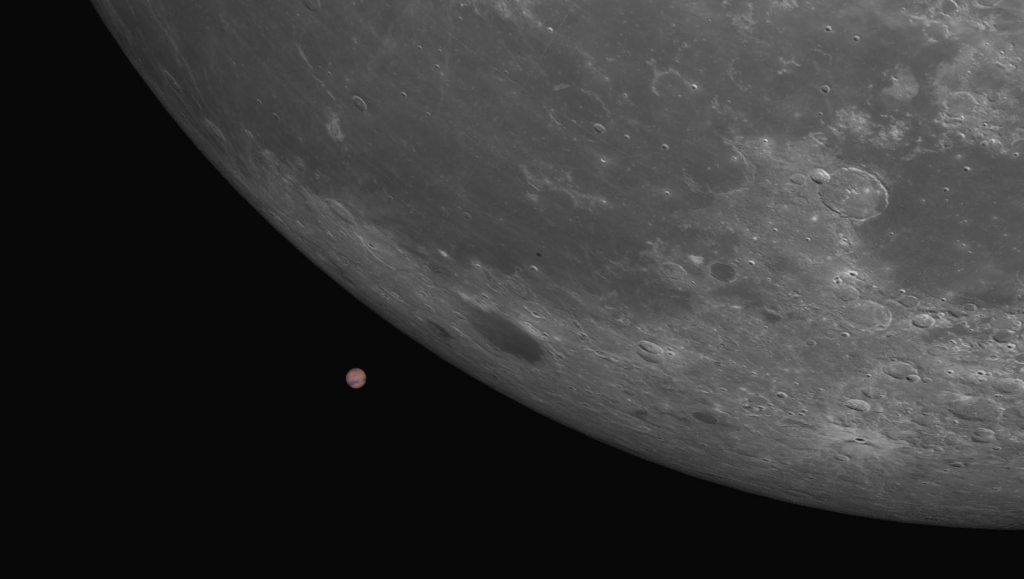Sky Report: December 5 – 11

Two minutes before the occultation Mars is a hairs-breadth from the moon. Note how tiny Mars is compared to the moon; it’s the size of a small lunar crater. Graphic created with SkySafariAstronomy.com.
Mars headlines the astronomy news this month. It was closest to earth on December 1 and at opposition on December 8. The meaning of “closest” is intuitive, while opposition is when Mars and the sun are precisely 180° opposite in the sky. These two dates would coincide if the orbits of earth and Mars were exactly circular, but they’re not; they’re elliptical, although the difference from circles is minor. All week Mars is as close as it will come this year – 50 million miles – and it rises in the northeast as the sun sets in the northwest and Mars is visible all night. It’s the brightest thing in the night sky after the moon and Jupiter, so you can’t miss it.
The next time Mars will be in opposition will be in January 2025 but it won’t come as close then as now. The next time Mars will be closer than this month is not until June 2033. Mars oppositions are explained especially well at https://www.nakedeyeplanets.com/mars-oppositions.htm.
In the early evening look for Mars low in the east. It gains altitude and moves westward as the hours pass, and at our latitude it’s nearly overhead at midnight. It’s in Taurus, above Orion, where it’s surrounded by the major winter constellations. Nearby are two of the three bright orange stars in the sky: Aldebaran in Taurus is straight to the right of Mars while Betelgeuse in Orion is twice as far and straight below; yellow-orange Mars easily outshines them both. The bright star to the upper left of the moon is Capella in Auriga.
Look for Mars in the southwest in morning twilight! Ninety minutes before sunrise Mars is a comfortable 20° high in the west, and on the mornings of the 7th and 8th it’s near the moon. How late can you see it as the sky brightens with the coming sunrise?
A wonderful highlight for Mars observers this week is a rare, and not-to-be-missed, occultation of Mars by the moon. The word “occultation” comes from “occult”, to hide, and astronomically an occultation is when one body hides another – in this case the moon hides Mars. On the evening of Wednesday December 7 the moon’s motion around the earth carries it in front of Mars, occulting Mars for 2 hours.
An hour after sunset that evening the moon is low in the east and Mars is 1°, or two moon-diameters, to the lower left of the moon. There are two motions at play. Both move westward as the sky turns (one motion) while the moon’s motion around the earth causes it to slowly approach Mars (second motion). At 7:36 the moon covers Mars in an event that takes about 35 seconds, and for the next two hours Mars is behind the moon. Mars reappears from behind the moon at the 2:00 position at 8:39. Watch with your eyes; binoculars are much better, and a telescope is by far best of all.
These times are for Kanab and are useful across southern Utah. For elsewhere use the interactive star chart at https://skyandtelescope.org/interactive-sky-chart/ or a planetarium app like SkySafari (which is what I use to write these Sky Reports). The occultation is visible from the 48 states except the southeast, Canada, and western Europe. A graphic shows this at https://in-the-sky.org/news.php?id=20221208_16_100.
The next occultation of Mars by the moon that is visible from North America happens on the evening of January 14, 2025.
The other planets visible tonight are brilliant Jupiter, twice as bright as Mars and halfway up the southern sky at around 7 p.m., and much fainter Saturn which is lower in the southwest and 40° from Jupiter. Saturn sets at around 10 p.m.
Stellar Vista Observatory provides portable telescopes and tripod mounted binocular kits on loan for free to residents and visitors in Kane County. Enhance your enjoyment of the night sky! For details or to request a loan, visit https://stellarvistaobservatory.org/discover-the-night-sky/ or drop in to the Kane County Office of Tourism.
The Sky Report is presented as a public service by the Stellar Vista Observatory, a nonprofit organization based in Kanab, Utah, which provides opportunities for people to observe, appreciate, and comprehend our starry night sky. Additional information is at www.stellarvistaobservatory.org. Send questions and comments to John@StargazingAdventures.org.





Comments are closed.